Black Narcissus, 1947, directed by Michael Powell and Emeric Pressburger, screenplay by Michael Powell and Emeric Pressburger, from the novel by Rumer Godden.
Cinema's a multidisciplinary medium. In a perfect movie, all of its various elements would work together toward a unified goal: writing, acting, cinematography, editing, score, and so on. But one can't have everything; even Citizen Kane has its Achilles' heel.1 Black Narcissus is a cinematographer's movie, a director's movie, an editor's movie, a composer's movie, and an actor's movie. It's got eye-poppingly beautiful Technicolor, and at least one unforgettable performance. On the other hand, the film's politics are cringeworthy, and the structure is truly bizarre: for one hour and ninteteen minutes, it's a travelogue/drama, and then it suddenly becomes a German expressionist horror film. It's absolutely essential viewing and an astonishing technical achievement. But a lot of it is pretty hard to watch.
Here's the premise: Deborah Kerr plays Sister Clodagh, one of the whitest, palest nuns in an exceptionally white and pale order. As the movie opens, she is appointed the youngest, whitest, and palest Mother Superior in the history of the order, and charged with establishing a school and hospital in the Himalayas. I'm not exaggerating how monochromatic Clodagh and her order are—the actresses wore flesh-colored lipstick so their lips wouldn't have too much color:
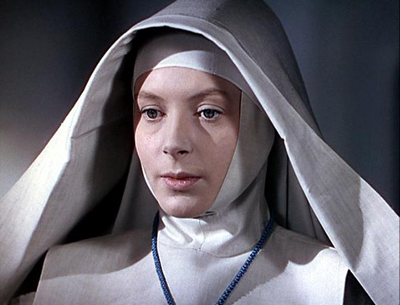
The location for the hospital and school has already been decided: a local general has donated the Palace of Mopu, which looks pretty innocuous when it's just a matte painting:
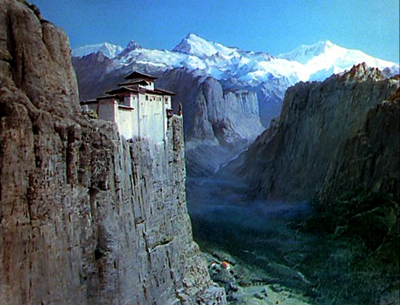
Inside, however, the murals and paintings give a hint of the palace's original function: living quarters for an older general's harem. It looks to have been a stately pleasure dome right out of Coleridge's most vivid opium dreams:

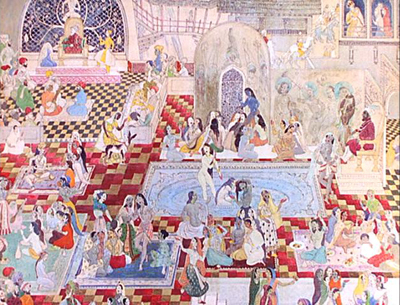
It's not the first time the general's tried to get a religious order to class the joint up; we're told that an order of monks made a go of it but only lasted a few months. The palace comes complete with a supremely unhelpful housekeeper who pines for the old days (May Hallet, looking more Native American than Indian, frankly; maybe there was a mixup in the costume department):

Security, general handiwork, and leering sexual innuendo are to be provided by British Agent Mr. Dean, played by David Farrar.
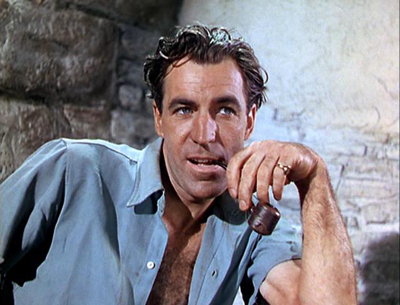
If you're thinking this might be a bad place for a nunnery, you're absolutely right. If you're also thinking Edward Said would have a field day with this movie, you win the Order of the British Empire. So let's run through it: Said's basic critique of Western depictions of the East was that Westerners infantilized, feminized, and eroticized the East to justify a system of colonial oppression and explotation. Black Narcissus soft-pedals the oppression part of the equation, but it's sure got the rest of it. Infantilization? Well, Powell and Pressburger start out with footage that could be from an Encyclopaedia Britannica 16mm film—happy native peasants, working away:
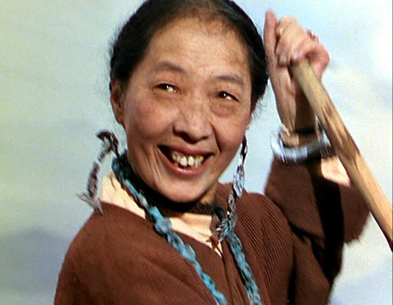
The first time the nuns actually meet the natives, they wow them with a water-to-wine trick that wouldn't play at a five-year-old's birthday party:
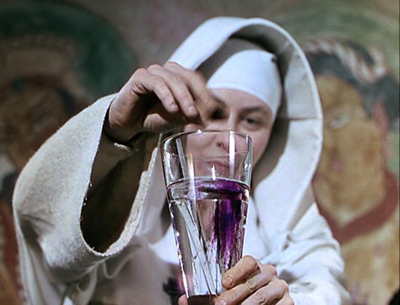
And the dialogue makes this explicit; as Mr. Dean puts it:
Well, you must remember, they're primitive people. Like children. Unreasonable children.
That's infantilization. Next on the checklist is feminizing and debasing Eastern masculinity. And no one else in the history of cinema could play a preening man-child like Sabu, who appears here as a self-absorbed general with all the mental acuity of a precocious first-grader. A picture is worth a thousand words:
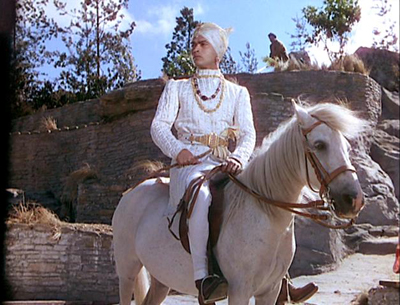
And the film's title refers to a perfume that Sabu's character wears. So there's your feminized masculinity. Last on the list: treating the East as the locus of eroticized, silenced Otherness. Well, how do you feel about Jean Simmons in brownface, eating a papaya?
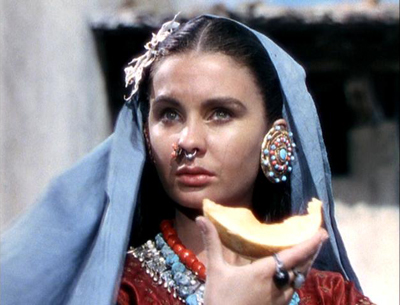
She doesn't have a single line in the entire movie, except when she screams in pain as she's whipped, she's sent to the nunnery because she won't stop trying to seduce Mr. Dean, and you can get a sense of the sexual politics around her character from this shot:
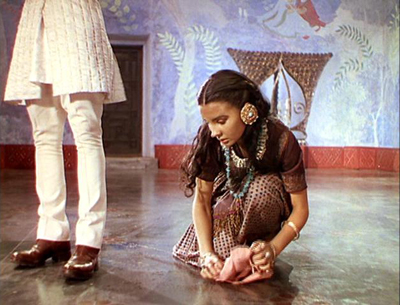
That's Sabu she's crouching in front of; hardly the epitome of masculinity himself. So there were plenty of times in Black Narcissus that I found myself cringing. And yet there are moments when it seems that Powell and Pressburger are in on the sick Colonialist joke. Here's one of the local children helping the nuns give an English lesson:
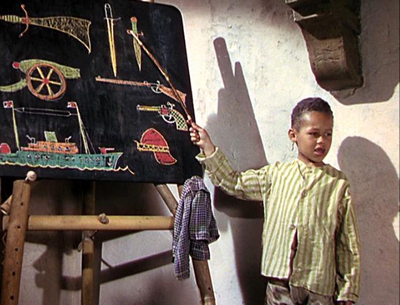
The class repeats after him as he teaches them the words "cannon," "warship," "bayonet," "dagger," and "gun." That's a joke that doesn't seem to be in the novel (at least if Google Books is to be believed). And this is a film that ultimately sees the nun's attempts to civilize the natives as a doomed enterprise. So it's not a classic Colonialist film, like, say, Gunga Din. It's pessimistic about the West's ability to impose order on the East.
Of course, whether you think Western rationalism will defeat Eastern superstition and sensuality or not, as soon as you frame things that way you've given up the game. And Black Narcissus isn't shy about condescending to the East; it's not exactly flattering to decide that the local culture is so hopeless and corrosive that it will destroy any Westerners who try to engage with it.
So why has the movie endured? The cinematography certainly doesn't hurt—this is the most beautifully photographed Technicolor film I've ever seen. But I think most of the film's reputation can be credited to the last act, even though that section represents a dramatic shift in tone.
Over the course of the film, there's a very slow increase in tension between Sister Clodagh and Sister Ruth, mostly caused by sexual jealousy and a mutual attraction to Mr. Dean. With twenty minutes left in the movie, that tension goes completely off the rails, and Powell and Pressburger are suddenly directing a horror film. Despite any problems I might have with the tactic of using India as a blank slate to project the psychosexual conflict between two Western women, the conflict itself is pretty compelling, because of a combination of Kathleen Byron's over-the-top performance and Jack Cardiff's cinematography. To give you some idea, here's Sister Ruth's descent into psychosexual madness in photos:
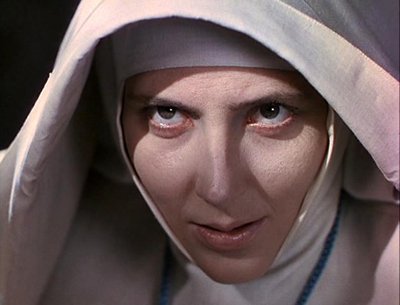
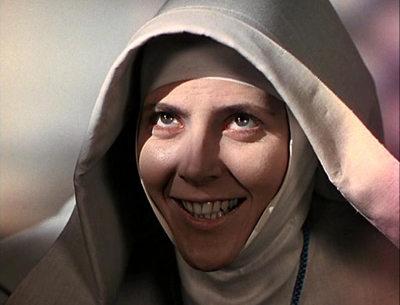



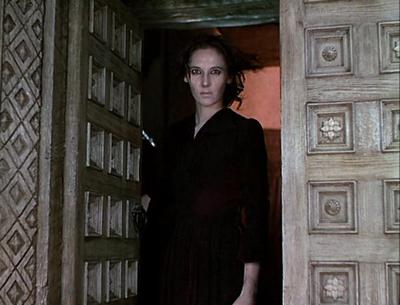
We can stand around and argue all day about whether or not it's a good idea to present female desire as something akin to demonic posession, but it's still unforgettable.2 For those twenty minutes, Black Narcissus is a master class in horror filmmaking.
Unfortunately, Kathleen Byron can't keep stalking around the frame forever, and at the end we're left with a strange mixture: a technically brilliant film that has something more than a little bit rotten at its core. Dave Kehr sees the final shots of the nuns leaving as the rains break as almost a moment of valedictory realism: a farewell to the Raj. I think that analysis misses a rather large point: the nunnery may have been a disaster, but Mr. Dean isn't going anywhere. Just because you can't civilize them doesn't mean they can't pick your tea.
Randoms
- Black Narcissus opened in the UK in May of 1947; it made its way to New York on Wednesday, the 13th of August. That Thursday and Friday, Pakistan and India became independent nations. So this may have been the last film about the British Empire released before it started collapsing in earnest.
- For the record, since I've kind of held Gunga Din up as the worst Colonialist film, I should note that whenever Sam Jaffe is off screen, I love it, warts and all. Like Black Narcissus, the good things about it are so good that they almost make up for the terrible parts. By the way, ever wonder why they cast Sam Jaffe in brownface to play the eponymous water-bearer? Sabu wasn't available. No, I'm not kidding—he really was the go-to guy for Indian stereotypes.
- The DVD includes an excerpt from Painting with Light, a documentary about Jack Cardiff's cinematography. It contains a lot of interesting information about the early days of Technicolor. Here's Cardiff in front of a three-strip Technicolor camera (note the extra wide film magazine: it would hold three reels in parallel).
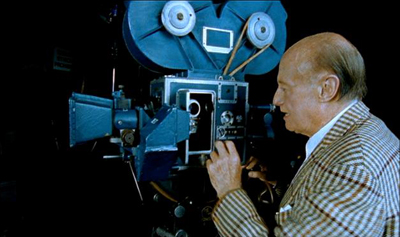
- That's a manageable size for a camera. But here's what the camera looked like when encased in the sound-damping equipment necessary to muffle the noise it made on set:
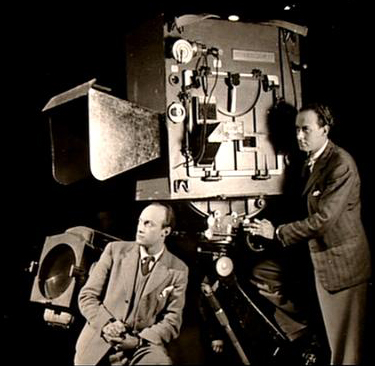
- It's positively cartoonish.
- For reasons that aren't entirely clear, Painting with Light also includes some color footage of the 110/5 interchange, which was replaced a long time ago with a giant stack interchange.
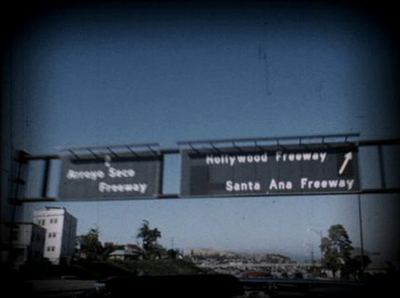
- The film's backdrops of the Himalayas were created from giant blow-ups of black and white photographs, which the art department colored by hand. The matte paintings are exceptionally good; here's one of the best.

- I only knew Jean Simmons from Great Expectations and Hamlet. It's unfortunate that the first time I saw her in color, she was in brownface. But I had no idea how lovely her eyes were.
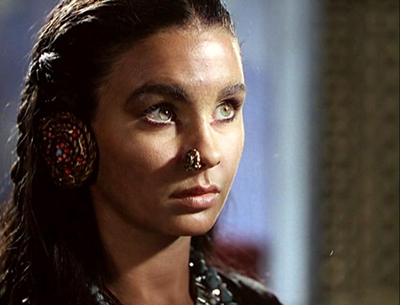
- Scorsese has nothing but praise for Cardiff's cinematography, for obvious reasons. Here's a shot he singled out for special praise, because of the light on the water. It's from a flashback to Sister Clodagh's civillian life.
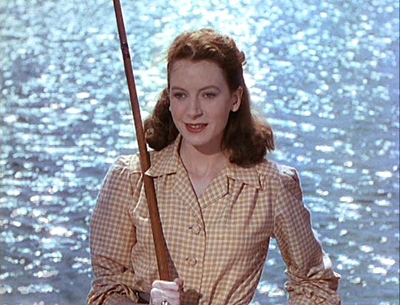
- I certainly agree that the water looks amazing. I also think this shot demonstrates just how perverse it is to cast Deborah Kerr in a Technicolor masterpiece and then hide her hair under a wimple for most of the movie.
- David Farrar's performance as Mr. Dean is pitch-perfect: he's charming, cynical, overtly sexual, and completely corrupt. I carefully chose the still I used of him in the main essay to highlight the things that are great about his performance. Now, the things that are not so great: his wardrobe and his pony.
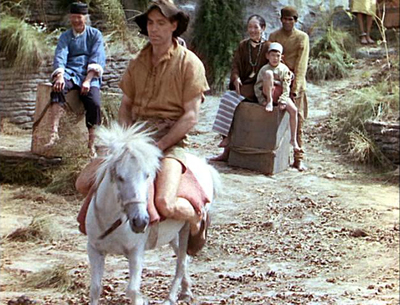
- So let's end with this cautionary photograph from the Journal of Poorly-Explained Haberdashery:

- People of the subcontinent, meet your ruler!
1It's Joseph Cotton's brief turn as "Crazy Ol' Grandpa Leland" in the nursing home scene.
2In our enlightened age, no one would make a movie with a character like Sabu's childlike general. But we keep churning out the Sister Ruths. It's lucrative.

